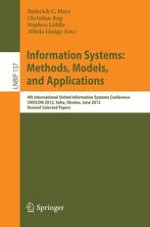2013 | Buch
Information Systems: Methods, Models, and Applications
4th International United Information Systems Conference, UNISCON 2012, Yalta, Ukraine, June 1-3, 2012, Revised Selected Papers
herausgegeben von: Heinrich C. Mayr, Christian Kop, Stephen Liddle, Athula Ginige
Verlag: Springer Berlin Heidelberg
Buchreihe : Lecture Notes in Business Information Processing
